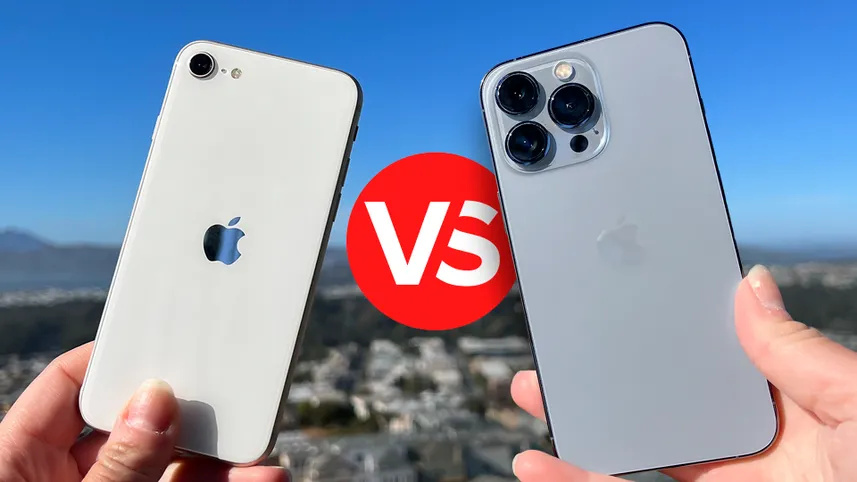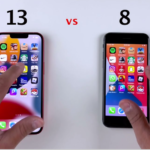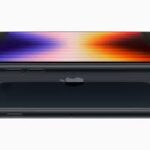Apple’s iPhone SE and iPhone 13 represent two distinctly different philosophies in smartphone design and marketing. On one hand, the iPhone SE is designed as an affordable yet powerful device that retains a classic iPhone design, while the iPhone 13 is a more contemporary, feature-packed model. This article aims to dissect the major differences and nuances between these two models to aid potential buyers in making an informed decision.
Related: iPhone 8 Compared to iPhone 13
iPhone SE vs iPhone 13
Are you trying to decide between the iPhone SE and the iPhone 13? You’re not alone. Both phones offer excellent value within the Apple ecosystem but cater to different user preferences. This in-depth comparison will help you pick the perfect iPhone for your needs.
Design and Display
| Feature | iPhone SE | iPhone 13 |
|---|---|---|
| Design | Classic design with Touch ID home button | Modern bezel-less design with Face ID |
| Display Size | 4.7-inch Retina HD LCD | 6.1-inch Super Retina XDR OLED |
| Display Resolution | 750 x 1334 pixels | 2532 x 1170 pixels |
The iPhone SE sports a nostalgic design reminiscent of the iPhone 8, featuring a 4.7-inch Retina HD display and thick bezels with a physical home button. In contrast, the iPhone 13 boasts a more modern aesthetic with a 6.1-inch Super Retina XDR display, minimal bezels, and Face ID technology. The choice between these could depend heavily on one’s preference for screen size and user interface—physical button versus Face ID.
Camera
| Feature | iPhone SE | iPhone 13 |
|---|---|---|
| Rear Camera | Single 12MP wide | Dual 12MP (wide + ultrawide) |
| Front Camera | 7MP | 12MP TrueDepth |
| Features | Night mode, Cinematic mode, Photographic Styles |
While both models feature powerful cameras, the iPhone 13’s dual-camera system (12 MP ultra-wide and wide cameras) offers significant advancements over the single 12 MP wide camera of the iPhone SE. The iPhone 13 also includes night mode and more advanced photographic styles, potentially making it a better choice for photography enthusiasts.
Performance and Battery Life
| Feature | iPhone SE | iPhone 13 |
|---|---|---|
| Processor | A15 Bionic chip | A15 Bionic chip |
| RAM | 4GB | 4GB |
| Battery Life | Up to 15 hours of video playback | Up to 19 hours of video playback |
Powered by the A15 Bionic chip, the iPhone 13 outperforms the iPhone SE’s A13 chip in raw processing power and energy efficiency. This leads to not only smoother performance but also longer battery life in the iPhone 13. Users looking for a device to handle more intensive tasks like gaming or video editing might find the iPhone 13 more appealing.
Software
Both iPhones run on iOS, but the iPhone 13 will likely receive software updates longer, given its newer hardware. This could be critical for those who keep their phones for many years.
Other Features
| Feature | iPhone SE | iPhone 13 |
|---|---|---|
| Storage Capacity | 64GB, 128GB, 256GB | 128GB, 256GB, 512GB |
| Water Resistance | IP67 | IP68 (more water resistant) |
| MagSafe | Not supported | Supported (enables wireless charging accessories) |
The iPhone 13 supports 5G connectivity, which is absent in the iPhone SE. Additionally, iPhone 13 offers better water resistance and a wider range of biometric security features thanks to Face ID, which the iPhone SE lacks, relying instead on Touch ID.
Pros & Cons
iPhone SE
Pros:
- Affordable price point
- Compact and lightweight design
- Powerful A15 Bionic chip
Cons:
- Smaller display size with thicker bezels
- Single rear camera limits photographic versatility
- Lacks Face ID and some newer features
iPhone 13
Pros:
- Larger, brighter Super Retina XDR display
- Dual-camera system with more shooting options
- Longer battery life
- Modern design with Face ID and MagSafe support
Cons:
- More expensive than the iPhone SE
Which Should You Buy?
- Choose iPhone SE if: You prioritize affordability, prefer a compact phone, and don’t need the latest camera features.
- Choose iPhone 13 if: You want a larger, more immersive display, a versatile dual-camera system, longer battery life, and the latest design features.
Who Should Upgrade?
If you’re using an older iPhone with a weaker processor or limited storage, iPhone SE and iPhone 13 offer significant upgrades. iPhone SE upgraders will gain a compact powerhouse, while iPhone 13 upgraders will experience a jump in display quality, camera capabilities, and battery life.
Who Can Stick With the iPhone SE?
iPhone SE users who are happy with the current design and functionality can hold onto their phone for a while longer, especially if budget is a major concern.
Final Thoughts
There’s no single “better” phone. The iPhone SE excels for budget-conscious users who prefer a compact design, while the iPhone 13 offers a more premium experience with a larger display, advanced camera system, and cutting-edge features. Consider your priorities and budget to make the right choice!
Related: iphone 15 Size Compared to iPhone 11
iPhone SE vs iPhone 13 FAQs
Q: Which iPhone is cheaper, the iPhone SE or the iPhone 13?
A: The iPhone SE starts at a lower price point than the iPhone 13.
Q: Which iPhone is newer, the iPhone SE or the iPhone 13?
A: Both phones use the latest A15 Bionic chip, but the iPhone 13 has a more recent design overall.
Q: Which iPhone has a bigger screen?
A: The iPhone 13 has a significantly larger 6.1-inch display than the 4.7-inch iPhone SE.
Q: Does the iPhone SE have Face ID?
A: No, the iPhone SE uses the Touch ID fingerprint sensor for secure unlocking. The iPhone 13 uses Face ID.
Q: How many rear cameras does the iPhone SE have?
A: The iPhone SE has a single rear camera.
Q: Does the iPhone 13 take better pictures than the iPhone SE?
A: Yes, the iPhone 13’s dual-camera system with ultrawide capabilities offers more versatility and potentially better photos.
Q: Which iPhone has a longer battery life?
A: The iPhone 13 offers a longer battery life compared to the iPhone SE.
Q: Who should get the iPhone SE?
A: This phone is ideal for budget-conscious users who prefer a compact design and don’t need the latest camera features.
Q: Who should get the iPhone 13?
A: This phone is a better choice for users who prioritize a larger display, a versatile camera system, longer battery life, and a modern design with Face ID.





